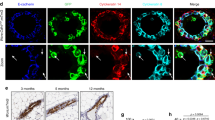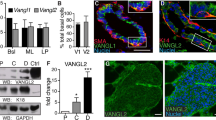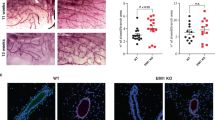Abstract
CEACAM1 (carcinoembryonic antigen-related cell adhesion molecule 1) is a type I transmembrane glycoprotein expressed in epithelial cells with three or four extracellular domains (ECDs) and either long or short cytoplasmic domain isoforms. We have previously shown that the four extracellular domains, short cytoplasmic domain isoform, CEACAM1-4S, plays an essential role in lumen formation in an in vitro model of mammary morphogenesis. In this study, we transfected MCF-7 cells with either the long or short cytoplasmic domain isoforms of CEACAM1, and grew the cells in humanized mammary mouse fat pads in NOD/SCID mice. In this in vivo model, only the long cytoplasmic domain isoform, CEACAM1-4L, formed glands with lumen. On the basis of other studies that revealed phosphorylation of key Thr and Ser residues in the short cytoplasmic domain, we introduced phosphorylation mimic (for example, Thr or Ser to Asp) or null (Thr or Ser to Ala) mutations into the cytoplasmic domain of CEACAM1-4S and tested them in the in vivo model. Mutation of either Thr or Ser to Asp or the double mutant Thr+Ser to Asp, but not the null mutants, induced gland formation with a central lumen-containing apoptotic cells. Moreover, the phosphorylation mimic mutants of CEACAM1-4S induced downregulation of β1-integrin, overexpression of β2-integrin, inhibited phosphorylation of focal adhesion kinase (pTyr-397) and resulted in myofibroblast differentiation as characterized by expression of vimentin, α-smooth muscle actin and β2-integrin, as well as the production of abundant extracellular matrix.
This is a preview of subscription content, access via your institution
Access options
Subscribe to this journal
Receive 50 print issues and online access
$259.00 per year
only $5.18 per issue
Buy this article
- Purchase on Springer Link
- Instant access to full article PDF
Prices may be subject to local taxes which are calculated during checkout








Similar content being viewed by others
References
Barnett TR, Drake L, Pickle II W . (1993). Human biliary glycoprotein gene: characterization of a family of novel alternatively spliced RNAs and their expressed proteins. Mol Cell Biol 13: 1273–1282.
Brummer J, Neumaier M, Gopfert C, Wagener C . (1995). Association of pp60c-src with biliary glycoprotein (CD66a), an adhesion molecule of the carcinoembryonic antigen family downregulated in colorectal carcinomas. Oncogene 11: 1649–1655.
Busch C, Hanssen TA, Wagener C, Obrink B . (2002). Down-regulation of CEACAM1 in human prostate cancer: correlation with loss of cell polarity increased proliferation rate, Gleason grade 3 to 4 transition. Hum Pathol 33: 290–298.
Chen CJ, Kirshner J, Sherman MA, Hu W, Nguyen T, Shively JE . (2007). Mutation analysis of the short cytoplasmic domain of the cell-cell adhesion molecule CEACAM1 identifies residues that orchestrate actin binding and lumen formation. J Biol Chem 282: 5749–5760.
Edlund M, Wikstrom K, Toomik R, Ek P, Obrink B . (1998). Characterization of protein kinase C-mediated phosphorylation of the short cytoplasmic domain isoform of C-CAM. FEBS Lett 425: 166–170.
Greenberg RS, Bernstein AM, Benezra M, Gelman IH, Taliana L, Masur SK . (2006). FAK-dependent regulation of myofibroblast differentiation. Faseb J 20: 1006–1008.
Huang J, Hardy JD, Sun Y, Shively JE . (1999). Essential role of biliary glycoprotein (CD66a) in morphogenesis of the human mammary epithelial cell line MCF10F. J Cell Sci 112: 4193–4205.
Huang J, Simpson JF, Glackin C, Riethorf L, Wagener C, Shively JE . (1998). Expression of biliary glycoprotein (CD66a) in normal and malignant breast epithelial cells. Anticancer Res 18: 3203–3212.
Huber M, Izzi L, Grondin P, Houde C, Kunath T, Veillette A et al. (1999). The carboxyl-terminal region of biliary glycoprotein controls its tyrosine phosphorylation and association with protein-tyrosine phosphatases SHP-1 and SHP-2 in epithelial cells. J Biol Chem 274: 335–344.
Kirshner J, Chen CJ, Liu P, Huang J, Shively JE . (2003a). CEACAM1-4S, a cell–cell adhesion molecule, mediates apoptosis and reverts mammary carcinoma cells to a normal morphogenic phenotype in a 3D culture. Proc Natl Acad Sci USA 100: 521–526.
Kirshner J, Schumann D, Shively JE . (2003b). CEACAM1, a cell–cell adhesion molecule, directly associates with annexin II in a three-dimensional model of mammary morphogenesis. J Biol Chem 278: 50338–50345.
Kleinerman DI, Dinney CP, Zhang WW, Lin SH, Van NT, Hsieh JT . (1996a). Suppression of human bladder cancer growth by increased expression of C-CAM1 gene in an orthotopic model. Cancer Res 56: 3431–3435.
Kleinerman DI, Zhang WW, Lin SH, Nguyen TV, von Eschenbach AC, Hsieh JT . (1995b). Application of a tumor suppressor (C-CAM1)-expressing recombinant adenovirus in androgen-independent human prostate cancer therapy: a preclinical study. Cancer Res 55: 2831–2836.
Kunath T, Ordonez-Garcia C, Turbide C, Beauchemin N . (1995). Inhibition of colonic tumor cell growth by biliary glycoprotein. Oncogene 11: 2375–2382.
Kuperwasser C, Chavarria T, Wu M, Magrane G, Gray JW, Carey L et al. (2004). Reconstruction of functionally normal and malignant human breast tissues in mice. Proc Natl Acad Sci USA 101: 4966–4971.
Laurie NA, Comegys MM, Carreiro MP, Brown JF, Flanagan DL, Brilliant KE et al. (2005). Carcinoembryonic antigen-related cell adhesion molecule 1a-4L suppression of rat hepatocellular carcinomas. Cancer Res 65: 11010–11017.
Leers MP, Kolgen W, Bjorklund V, Bergman T, Tribbick G, Persson B et al. (1999). Immunocytochemical detection and mapping of a cytokeratin 18 neo-epitope exposed during early apoptosis. J Pathol 187: 567–572.
Luo W, Tapolsky M, Earley K, Wood CG, Wilson DR, Logothetis CJ et al. (1999). Tumor-suppressive activity of CD66a in prostate cancer. Cancer Gene Ther 6: 313–321.
Luo W, Wood CG, Earley K, Hung MC, Lin SH . (1997). Suppression of tumorigenicity of breast cancer cells by an epithelial cell adhesion molecule (C-CAM1): the adhesion and growth suppression are mediated by different domains. Oncogene 14: 1697–1704.
Mitra SK, Schlaepfer DD . (2006). Integrin-regulated FAK-Src signaling in normal and cancer cells. Curr Opin Cell Biol 18: 516–523.
Neumaier M, Paululat S, Chan A, Matthaes P, Wagener C . (1993). Biliary glycoprotein, a potential human cell adhesion molecule, is down-regulated in colorectal carcinomas. Proc Natl Acad Sci USA 90: 10744–10748.
Nittka S, Gunther J, Ebisch C, Erbersdobler A, Neumaier M . (2004). The human tumor suppressor CEACAM1 modulates apoptosis and is implicated in early colorectal tumorigenesis. Oncogene 23: 9306–9313.
Nollau P, Scheller H, Kona-Horstmann M, Rohde S, Hagenmuller F, Wagener C et al. (1997). Dysregulation of carcinoembryonic antigen group members CGM2, CD66a (biliary glycoprotein), and nonspecific cross-reacting antigen in colorectal carcinomas. Comparative analysis by northern blot and in situ hybridization. Cancer Res 57: 2354–2357.
Obrink B . (1997). CEA adhesion molecules: multifunctional proteins with signal-regulatory properties. Curr Opin Cell Biol 9: 616–626.
Ohwada A, Takahashi H, Nagaoka I, Kira S . (1994). Biliary glycoprotein mRNA expression is increased in primary lung cancer, especially in squamous cell carcinoma. Am J Respir Cell Mol Biol 11: 214–220.
Park CC, Zhang H, Pallavicini M, Gray JW, Baehner F, Park CJ et al. (2006). Beta1 integrin inhibitory antibody induces apoptosis of breast cancer cells, inhibits growth, and distinguishes malignant from normal phenotype in three dimensional cultures and in vivo. Cancer Res 66: 1526–1535.
Peters T, Sindrilaru A, Hinz B, Hinrichs R, Menke A, Al-Azzeh EA et al. (2005). Wound-healing defect of CD18 (−/−) mice due to a decrease in TGF-beta1 and myofibroblast differentiation. Embo J 24: 3400–3410.
Powell DW, Adegboyega PA, Di Mari JF, Mifflin RC . (2005). Epithelial cells and their neighbors I. Role of intestinal myofibroblasts in development, repair, and cancer. Am J Physiol Gastrointest Liver Physiol 289: G2–G7.
Powell DW, Mifflin RC, Valentich JD, Crowe SE, Saada JI, West AB . (1999). Myofibroblasts. II. Intestinal subepithelial myofibroblasts. Am J Physiol 277: C1–C9.
Schumann D, Chen CJ, Kaplan B, Shively JE . (2001). Carcinoembryonic antigen cell adhesion molecule 1 directly associates with cytoskeleton proteins actin and tropomyosin. J Biol Chem 276: 47421–47433.
Shi S-R, Cote RJ, Taylor CR . (2001). Antigen retrieval techniques: current perspectives. J Histochem Cytochem 49: 931–937.
Svenberg T, Hammarstrom S, Zeromski J . (1979). Immunofluorescence studies on the occurrence and localization of the CEA-related biliary glycoprotein I (BGP I) in normal human gastrointestinal tissues. Clin Exp Immunol 36: 436–441.
Tanaka K, Hinoda Y, Takahashi H, Sakamoto H, Nakajima Y, Imai K . (1997). Decreased expression of biliary glycoprotein in hepatocellular carcinomas. Int J Cancer 74: 15–19.
Tomasek JJ, Gabbiani G, Hinz B, Chaponnier C, Brown RA . (2002). Myofibroblasts and mechano-regulation of connective tissue remodelling. Nat Rev Mol Cell Biol 3: 349–363.
Wagener C, Clark BR, Rickard KJ, Shively JE . (1983). Monoclonal antibodies for carcinoembryonic antigen and related antigens as a model system: a systematic approach for the determination of epitope specificities of monoclonal antibodies. J Immunol 130: 2302–2307.
Author information
Authors and Affiliations
Corresponding author
Rights and permissions
About this article
Cite this article
Yokoyama, S., Chen, CJ., Nguyen, T. et al. Role of CEACAM1 isoforms in an in vivo model of mammary morphogenesis: mutational analysis of the cytoplasmic domain of CEACAM1-4S reveals key residues involved in lumen formation. Oncogene 26, 7637–7646 (2007). https://doi.org/10.1038/sj.onc.1210577
Received:
Revised:
Accepted:
Published:
Issue Date:
DOI: https://doi.org/10.1038/sj.onc.1210577
Keywords
This article is cited by
-
Loss of CEACAM1 is associated with poor prognosis and peritoneal dissemination of patients with gastric cancer
Scientific Reports (2019)
-
The role of CEA-related cell adhesion molecule-1 (CEACAM1) in vascular homeostasis
Histochemistry and Cell Biology (2016)
-
P4H9-detected molecule expression on spindle-shaped fibroblasts indicates malignant phenotype of colorectal cancer
British Journal of Cancer (2015)
-
CEACAM1 and hollow spheroid formation modulate the chemosensitivity of colorectal cancer to 5-fluorouracil
Cancer Chemotherapy and Pharmacology (2015)
-
Signaling by epithelial members of the CEACAM family – mucosal docking sites for pathogenic bacteria
Cell Communication and Signaling (2014)



